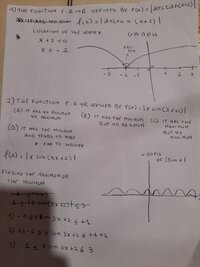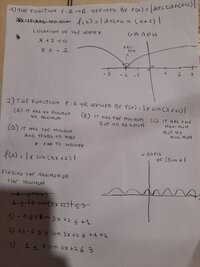You are using an out of date browser. It may not display this or other websites correctly.
You should upgrade or use an alternative browser.
You should upgrade or use an alternative browser.
Maximum and Minimum of functions f(x) = |x sin(3x+2)|, f(x) = |arctan(x+2)|
- Thread starter Leila
- Start date
- Joined
- Feb 4, 2004
- Messages
- 16,550
To get started, one might consider the graphs before splitting into cases and differentiating.How can I find the maximum and minimum of these two functions?
1) the function f : R → R defined by f(x) = |x sin(3x+2)|
2) the function f : R → R defined by f(x) = |arctan(x+2)|
Please re-read the "Read Before Posting" message, and reply with the requested information. Thank you!
Eliz.
Dr.Peterson
Elite Member
- Joined
- Nov 12, 2017
- Messages
- 16,865
Take the derivative, and find where it is either zero or undefined. Then check each of those points.How can I find the maximum and minimum of these two functions?
1) the function f : R → R defined by f(x) = |x sin(3x+2)|
2) the function f : R → R defined by f(x) = |arctan(x+2)|
Thanks
Note that you can take the derivative of the function inside the absolute value, and also consider where that function is zero.
Please show your work, so we can see where you need help.
To get started, one might consider the graphs before splitting into cases and differentiating.
Please re-read the "Read Before Posting" message, and reply with the requested information. Thank you!
Eliz.
I saw a video on youtube where they said that with the absolute value there was no need to find the derivative.Take the derivative, and find where it is either zero or undefined. Then check each of those points.
Note that you can take the derivative of the function inside the absolute value, and also consider where that function is zero.
Please show your work, so we can see where you need help.
As for sine I think this doesn't apply, the D and A are false because the general sine(x) function has both the minimum and the maximum, but for the B and C idk. With the sine function I can't figure out where I'm wrong also the graph is wrong, I only traced the general one I can't figure out how to represent it (then I'll try to see other videos on youtube)
So the function f : R → R defined by f(x) = |arctan(x+2)| it has the minimum but no maximum
the function f : R → R defined by f(x) = |x sin(3x+2)| (idk) ?
Attachments
To get started, one might consider the graphs before splitting into cases and differentiating.
Please re-read the "Read Before Posting" message, and reply with the requested information. Thank you!
Eliz.
Take the derivative, and find where it is either zero or undefined. Then check each of those points.
Note that you can take the derivative of the function inside the absolute value, and also consider where that function is zero.
Please show your work, so we can see where you need help.
Trying to post again my work, even I posted 3 days ago but my message doesn't show up.
Idk why but I see others people posting on calculus section,
Anyway
I saw a video on youtube where they said that with the absolute value there was no need to find the derivative.
As for sine I think this doesn't apply, the D and A are false because the general sine(x) function has both the minimum and the maximum, but for the B and C idk. With the sine function I can't figure out where I'm wrong also the graph is wrong, I only traced the general one I can't figure out how to represent it (then I'll try to see other videos on youtube)
So the function f : R → R defined by f(x) = |arctan(x+2)| it has the minimum but no maximum
the function f : R → R defined by f(x) = |x sin(3x+2)| (idk) ?

Dr.Peterson
Elite Member
- Joined
- Nov 12, 2017
- Messages
- 16,865
I'd have said you need the derivative to find relative maxima and some minima, but need to separately consider where the function itself is zero, which provides additional minima.I saw a video on youtube where they said that with the absolute value there was no need to find the derivative.
Your graph for the first problem looks as if there were maxima, but the idea is right. In terms of derivatives, you'll find no maxima, but the x-intercept gives the minimum.As for sine I think this doesn't apply, the D and A are false because the general sine(x) function has both the minimum and the maximum, but for the B and C idk. With the sine function I can't figure out where I'm wrong also the graph is wrong, I only traced the general one I can't figure out how to represent it (then I'll try to see other videos on youtube)
So the function f : R → R defined by f(x) = |arctan(x+2)| it has the minimum but no maximum
the function f : R → R defined by f(x) = |x sin(3x+2)| (idk) ?
The second problem is a lot harder to graph by hand, so I presume you're expected to differentiate and find x-intercepts. I don't think the work you show can help.
Now that you've posted a few times, you probably won't have any more delays.

